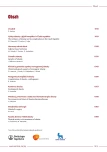The incidence of obesity and its complications in the Czech Republic
Authors:
M. Matoulek; Š. Svačina; J. Lajka
Authors‘ workplace:
III. interní klinika 1. lékařské fakulty UK a VFN Praha, přednosta prof. MU Dr. Štěpán Svačina, DrSc., MBA
Published in:
Vnitř Lék 2010; 56(10): 1019-1027
Category:
Obesity 2010
Overview
Over the recent years, the incidence of obesity is continuously rising. A research conducted in 2008– 2009 on a representative sample of Czech population (n = 2,058) suggests that 23% of adult population of the Czech Republic are obese and 34% are overweight. This represents an increase of 5% in the number of obese people (17% vs. 22%), while the number of overweight remains practically the same (35% vs. 34%). A more significant shift in female waist circumference compared to male has also been shown. The incidence of hypertension in the evaluated sample was more than a two‑fold higher in obese participants (48 % vs. 21 %) and as much as 3- fold higher in type 2 diabetes mellitus (7% vs. 20%). The risk of body weight increase is the highest between 50th and 59th year of age, where hypertension and diabetes are the most frequently diagnosed. The risk of obesity in adulthood is mostly carried over from childhood and more than 3/4 (77%) of those, who were overweight or obese as children, are in these categories as adults. Quality of life and satisfaction with own health is more related to BMI than age. Even though body weigh is increasing with the same amplitude in sportsman and physically active people, they are reaching lower final BMI due to their lower starting body weight. It is clear that physically active lifestyle in younger age is the best predictor of lower BMI in adult life. Consumption of secondary processed meat and lower consumption of fruit and vegetables are important factors in adulthood.
Key words:
obesity – overweight – type 2 diabetes mellitus – hypertension – physical activity – quality of life – meat consumption – vegetable consumption
Sources
1. Kunešová M. Životní styl a obezita v České republice – hlavní zjištění studie. Available from: http:/ / www.stemmark.cz/ download/ press_release_obezita_Kunesova.pdf.
2. Hainer V, Kunesová M, Bellisle F et al. The Eating Inventory, body adiposity and prevalence of diseases in a quota sample of Czech adults. Int J Obes (Lond) 2006; 30: 830– 836.
3. Wagenknecht M, Hainer V, Kunesová M et al. Relationships between the “eating inventory” factors, socioeconomic status, anthropometric body adiposity indexes and health risks in Czech population. Čas Lék Česk 2007; 146: 284– 291.
4. Rosengren A, Lissner L. The Sociology of Obesity. In: Korbonits M (ed). Obesity and Metabolism. Front Horm Res Basel Karger 2008; 36: 260– 270.
5. Hernández- Mijares A, Solá- Izquierdo E, Ballester-Mechó F et al. Obesity and overweight prevalences in rural and urban populations in East Spain and its association with undiagnosed hypertension and diabetes mellitus: a cross- sectional population‑based survey. BMC Res Notes 2009; 2: 151.
6. Milanović SM, Uhernik AI, Fister K. Health behavior factors associated with obesity in the adult population in Croatia. Coll Antropol 2009; 33 (Suppl 1): 67– 73.
7. Lebel A, Pampalon R, Hamel D et al. The geography of overweight in Quebec: a multilevel perspective. Can J Public Health 2009; 100: 18– 23.
8. Boledovicova M, Saradyova L, Svacina S.Comparison of dietary habits and leisure time activities in school children of rural and town population in relation to obesity. Int J Obesity 2008; 32: 128.
9. The British Heart Foundation. Prevelance of overweight and obesity in Europe. Available from: http:/ / www.heartstats.org/ topic.asp?id=4741.
Labels
Diabetology Endocrinology Internal medicineArticle was published in
Internal Medicine

2010 Issue 10
Most read in this issue
- Genetics of obesity
- Adipose tissue hormones
- Obesity prevention
- The incidence of obesity and its complications in the Czech Republic
